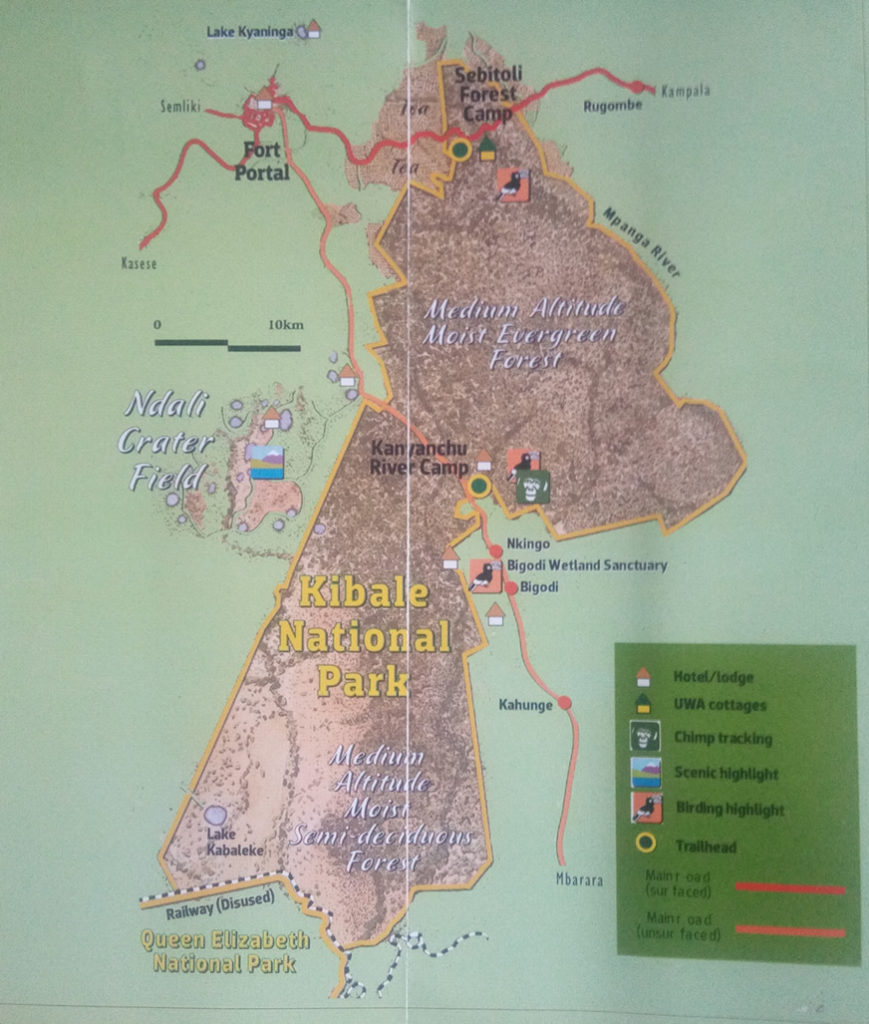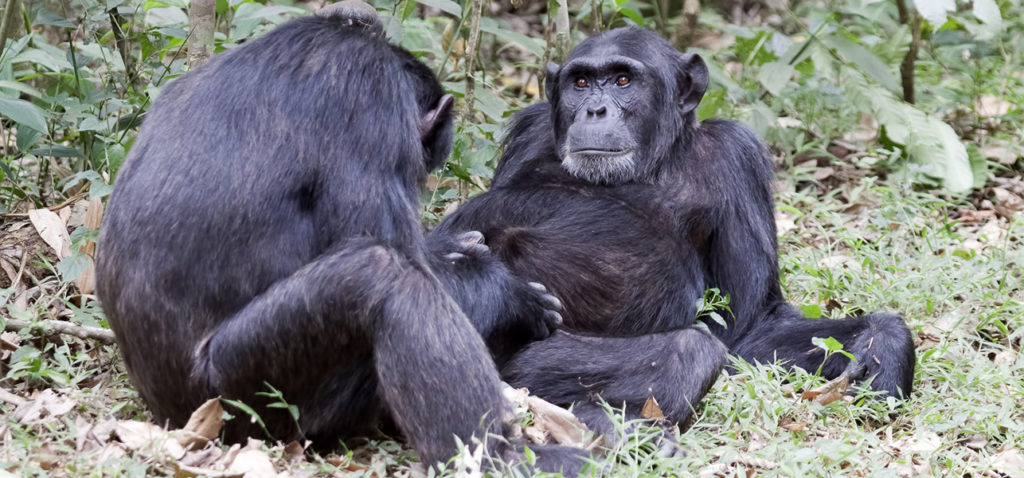Kibale Forest National Park
Kibale Forest National Park is seated at about 795 square kilometers, forming a contiguous block with Queen Elizabeth National Park, on an altitude of 1,100 to 1,590m above sea level. This largely forested park is mainly renowned for its variety of primates including both diurnal and nocturnal.
It was established as a game reserve back in the 1940’s and later upgraded to a National Park status.
Map of Kibale Forest National Park

Attractions in Kibale Park
Kibale Forest has a lot to offer to all kinds of tourists, from researchers, travelers and adventurists. Its biodiversity includes 350 tree species, 71 mammal species, and 370 bird species among others in addition to its plateaued landscape in the Northern and Central part and vegetation.
The main tourism site in Kibale Forest National Park is at Kanyanchu that is about 35 km South East of Portal and Sebitoli that is only 16km East of Forportal.
Vegetation
The vegetation of this forested park is dominated by the tropical rainforest. More than 250 species of tree have been recorded to be existent in the park.
However, as it extends to the South, the vegetation starts to get bushy along the rift valley escarpment and drops down to the grasslands on the rift valley floor. It is this kind of vegetation that gives the park a diversity of wildlife species including the 13 primates’ species, which the park is famed of.
Wildlife
Wildlife itself is outstanding in the park. Though the park is largely renowned as the Primates Park of Uganda, it also habits other species such as elephants, buffaloes, hippos, warthog, bush pigs, duikers on its list of over 70 mammals.
Besides that, the bird list records 372 species, of which four cannot be seen anywhere else. These include the Nathan’s francolin, Cassin’s spine tail, blue-headed bee-eater and masked apalis. The park also has other special birds including the African Pitta, Kibale Ground thrush, Yellow rumped tinkerbird, crowned eagle among others.
Primates in Kibale
Kibale is well known for sighting primates, counting 13 species. Particularly, it hosts a large population of chimpanzees estimated to be about 1450 in number. There are also vervet, red-tailed, L’Hoest’s and blue monkeys, red Colobus, black and white Colobus, patas monkeys, De brazza’s monkey, olive baboons, pottos, bush babies/ Galgoes akong others.
The park also habits Uganda’s only endemic monkey species; the Uganda Mangabey known scientifically as Lophocebus Ugandae, though it was for long mistaken with the Grey-Cheeked Mangabey (L. Albigena), only to be found distinct in 2007.
The People
The Local people found in the park are also an attraction to the cultural enthusiasts. Around the park, live the indigenous Batoro and Bakiga. Just like other tribes in Uganda such as the Baganda, Batoro take pride in the cultural heritage of their kingdom despite the Western culture influence in the regions. Their supreme leader, the Omukama (king) embodies the traditional norms and cultural values that includes the dance (Olunyege), dressing (omushanana), and food that includes Firinda among others.
The Bakiga also still preserve their tradition and culture through folklore, dance and language.
Tour Activities in Kibale
Chimpanzee Tracking & Habituation
Possible tour activities in Kibale are topped by Chimpanzee tracking since the main attractions of the park are the chimps. There is over a 90% of observing the chimpanzees from the Kanyanchu gate during a primate walk.

Walks are possible both in the morning and the evening, with leaving the Kanyanchu visitor’s center at 8am, 11am, and 2pm. The walk last between 2 – 5 hours and once you’ve met these playful apes, you are only allowed to spend one hour observing their way of life and taking photos. Six people per group are allowed to track the chimps at a time and must be aged above 16.
On the other hand, the chimpanzee Habituation Experience (CHEX) allows you to follow chimpanzees during their daily activity, thereby getting them used to human presence without altering their normal behavior.
This is an all-day activity. Early visitors may be able to see the spectacular scene of chimps de-nesting, copulating, hunting, breastfeeding, resting, patrolling and displaying until they build new nests and retire for the night around 7.00pm. Chimpanzee habituation in Kibale Forest is at USD 200.
Nature & Night Walks
A nature walk is much ideal for young visitors below 16 who are not allowed to track the chimpanzees, thereby being unable accompany their elders on a primate Walk. On the nature walk, you will spot a variety of birdlife alongside different kinds of monkeys, reptiles, medicinal plants among others. These are conducted during the same time as Chimp tracking.
A walk through the forest in the dark is ideal for visitors who would like to spot nocturnal creatures such as galagoes, pottos and bush babies. This starts from 7pm to 10pm.
Birding
This is the second main tour activity done in Kibale. The bird list of Kibale include the forest, grassland and swamp species that includes local endemics and central Africa specials. All these can be sought with the help a guide either from the tour agency that conducted your journey or one from the Uganda Wildlife Authority during a forest trail at both Sebitoli and Kanyanchu tourism sites.
Bird lovers can combine their Bird watching experience at the popular Bigodi, a trading center just outside the Park’s boundary within the Bigodi Wetland Sanctuary. The activity consists of a guided walk through the Magombe swamp, with the possibility to see among others the great blue Turaco and the papyrus gonolek.
How to get there
Kibale National Park is located in western Uganda, 26km south-east of Fort Portal town and can be reached from Kampala by a number of routes.
Road
Kanyanchu River Camp, the primary centre for tourism activities, can be reached from Kampala either from the north, via Mubende and Fort Portal, or the south through Mbarara and Kamwengye.
The northern approach is shorter and quicker, with a 335km tarmac road running to Fort Portal followed by 36km on murram to Kanyanchu.
Sebitoli Forest Camp, a secondary tourism centre, is even easier to reach. This stands directly on the Kampala road, 16km before Fort Portal.
Public transport runs throughout the day between Kampala and Fort Portal (passing Sebitoli) and Fort Portal and Kamwengye (passing Kanyanchu).
Air
Kibale can also be reached by Air. The park has access to two Airstrips. The Nyakisharara near Mbarara that is 100km on tarmac and Kasese that is 60km on surfaced and dirt roads.
Accommodations
There are several accommodation facilities in Kibale ranging from Upmarket, midrange to economy.
- Luxury: Kyaninga lodge, Ndali lodge, Kibale safari lodge, Kibale primate cottages
- Mid-range and Budget: Kibale safari camp, Chimp nest, Chimpanzee guest house, Fort motel, CVK lodge (Mid-range)
Others to Note:
The climate of Kibale is generally pleasant with a mean annual temperature range of 14 – 27 degrees Celsius. The park is hot and dry on the rift valley floor in the South and wet & cold in the Northern part, that is forested receiving a mean annual rainfall of up to 1700mm mostly during March – May and September to November.
However, the park can be visited at any time of the year though it often rains in the afternoons during the wet months.

